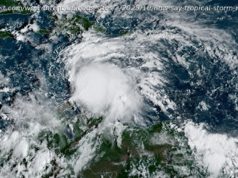Dozens of Times journalists are covering two powerful storms on opposite sides of the globe.
Updated Sept. 16
Two powerful storms are threatening lives and livelihoods after making landfall this week on opposite ends of the earth — Tropical Depression Florence, which battered the North Carolina coast with strong winds and blinding rain, and Typhoon Mangkhut, which packed winds as high as 200 miles an hour and slammed the northern Philippines before moving to menace Hong Kong and southern China.
Dozens of Times journalists around the world are covering the two storms. We are providing open and unlimited access to our coverage.
Here’s how to help those affected by Florence and by Mangkhut .
After slamming into the Carolina coast on Friday with a destructive power unlike any the area has seen in a generation, the Florence system has been downgraded to a tropical depression. At least 14 people have died, hundreds of thousands were without power and rescue crews were trying to pluck distressed residents from rooftops. Even though the slow-moving storm has begun to speed up, leaving less time for its driving rains to saturate the region, rivers have already risen dangerously, threatening worse flooding.
For the latest, check Sunday’s live updates, pictures from our photojournalists on the ground and maps tracking the storm .
Forecasters were predicting up to 40 inches of rainfall and dangerous flooding in what Gov. Roy Cooper of North Carolina has called a “monster” storm. The coastal town of New Bern, N. C., was inundated: “Downtown is literally underwater,” said Jameesha Harris, an alderwoman.
Like Hurricane Harvey last year, Florence is expected to continue to progress slowly, meaning it could stall over the region, dumping rain and harsh wind for days. Lingering storms can be problematic, and researchers say that tropical cyclones, including hurricanes, have become slower since the mid-1900s.
Here’s what it’s like for the thousands seeking shelter from Florence, for those who decided to stay put and for rescue crews trying to help the people who did not evacuate. You can also hear directly from Times readers in the storm’s path who have shared their experiences with us.
On the other side of the world, Typhoon Mangkhut made landfall on the southeastern coast of China on Sunday after battering Hong Kong hours before. The storm has killed 59 people in the Philippines, according to an unofficial count from the police.
Follow our live updates and track the storm’s location .
The typhoon was expected to weaken as it passed over mainland China, but it has already taken a considerable toll: Landslides in the Philippines buried dozens, including people sheltering in a church and a dormitory for miners, and the death toll there was expected to rise sharply as rescue workers began moving in.
But there was also relief that the situation was not worse. There were no signs of the kind of the mass devastation wreaked by Typhoon Haiyan, which claimed more than 6,000 lives in 2013.
Why is Mangkhut called a typhoon while Florence was called a hurricane? It’s all about location. A “super” typhoon is one with sustained wind speeds of at least 150 miles per hour. The typhoon had been the equivalent of a Category 5 hurricane, but has weakened.
News reports about Florence may be laden with words like landfall, eyewall and flood plain. Here’s what storm terms actually mean. Florence, which was a Category 4 storm as of early Wednesday, was downgraded to a tropical storm on Friday. Here’s an explanation of the different categories.
If you are in an affected area, here are five things you can do to avoid the dangers of flooding .
Evacuation orders can pose special challenges for the elderly and disabled. Here’s expert advice for those who cannot or will not evacuate.
We also have tips for travelers affected by the storm and advice on how to use technology to your advantage. Read our guide to preparing for Florence and other storms.






